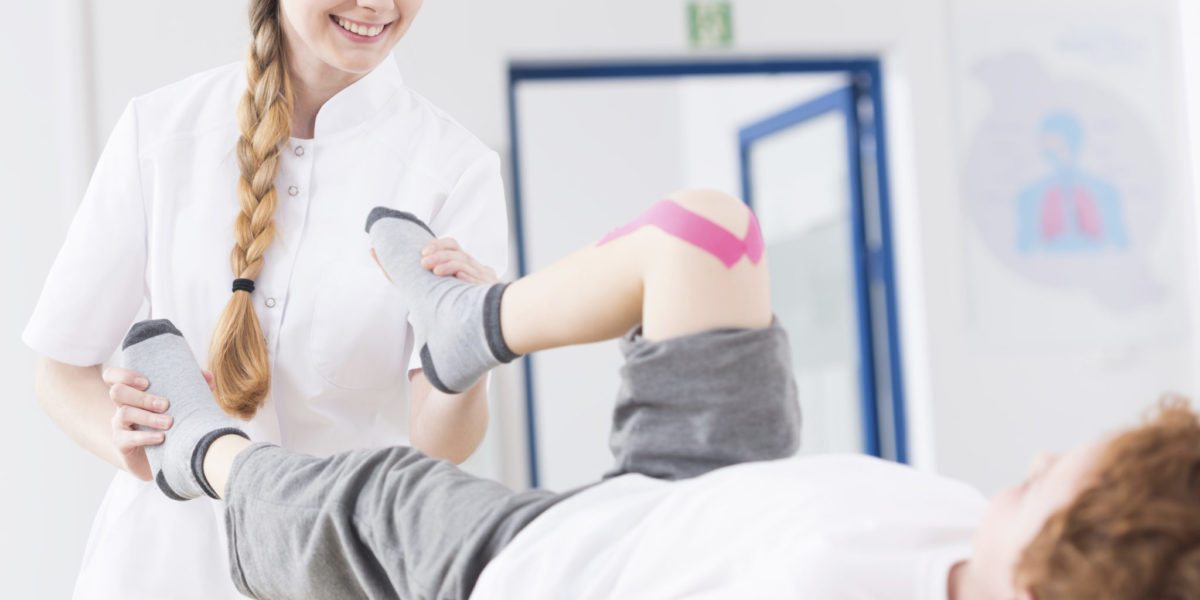 Physical therapy aims to assist in the development of both fine and gross motor skills throughout a person’s lifespan, but especially at an early age when a child’s brain and body are still developing. Physical therapists (PTs) help increase strength, endurance and coordination to help individuals become more independent in specific tasks. They are also trained in pain relief and swelling reduction techniques, which can include:
Physical therapy aims to assist in the development of both fine and gross motor skills throughout a person’s lifespan, but especially at an early age when a child’s brain and body are still developing. Physical therapists (PTs) help increase strength, endurance and coordination to help individuals become more independent in specific tasks. They are also trained in pain relief and swelling reduction techniques, which can include:
- Therapeutic exercise
- Heat and cold applications and
- Electrical stimulation to the muscles
PTs are in charge of coordinating complete physical therapy care plans, which can include networking with the child’s primary care physician, providing services that prevent or slow the onset of health conditions that can stem from a patient’s original injury or disease, and helping the patient learn how to use assistive or adaptive devices.
What is physical therapy session like?
 Physical therapy usually consists of sessions in a formal therapeutic environment under the supervision of a certified physical therapist. When children are not at therapy sessions, parents are often given exercises for their children to do at home on a schedule.
Physical therapy usually consists of sessions in a formal therapeutic environment under the supervision of a certified physical therapist. When children are not at therapy sessions, parents are often given exercises for their children to do at home on a schedule.
These exercises can include:
- Range of motion (ROM) exercises for maintaining the mobility of joints and soft tissues and preventing contractures
- Progressive resistance exercises for building muscle strength
- Exercises for strengthening knee extensor muscles improve crouching and stride length
- Postural and motor control exercises help kids control their posture and hold themselves upright
The type of physical therapy a child is enrolled in depends on many factors, including the child’s current abilities and health history. Each physical therapy service provider will be able to provide a different range of services, so not all types of physical therapy will be available everywhere. It is also important to remember that not all physical therapy modalities are equally effective – research surrounding intensive suit therapy is, for example, inconclusive, though this does not necessarily discount its usefulness for certain children.
Motion and Gait Analysis
 One aspect of certain physical therapy programs is a technologically advanced system of diagnosis called ‘motion and gait analysis.’ In gait analysis, specialists use advanced computer programs to map out a person’s movement, muscle activity and other factors that impact their gait.
One aspect of certain physical therapy programs is a technologically advanced system of diagnosis called ‘motion and gait analysis.’ In gait analysis, specialists use advanced computer programs to map out a person’s movement, muscle activity and other factors that impact their gait.
Gait analysis provides a valuable method of pinpointing problems unique to each individual patient. It in turn allows physical therapists to develop a more targeted and individualized physical therapy program for maximal effectiveness.
Organizations in the United States with Gait Analysis Laboratories
There are many motion analysis facilities in the United States, many of which are housed in children’s hospitals. The vast majority work with both children and adults. The following is not a comprehensive list, but these gait analysis laboratories can provide you with an analysis of your child’s gait abnormalities:
 Gillette Children’s Hospital (James R. Gage Center for Gait and Motion Analysis) – St. Paul, Minnesota
Gillette Children’s Hospital (James R. Gage Center for Gait and Motion Analysis) – St. Paul, Minnesota- Rehabilitation Institute of Chicago – Chicago, Illinois
- Nemours Children’s Health System– Wilmington, Delaware
- Stanford Children’s Hospital – Menlo Park, California
- Children’s Hospital Colorado Center for Gait and Movement Analysis (CGMA) – Aurora, Colorado
- Hospital for Special Surgery – Leon Root, M.D. Motion Analysis Laboratory – New York, New York
- Penn Physical Medicine and Rehabilitation Gait and Biomechanics Laboratory – Philadelphia, Pennsylvania
- Spaulding Rehabilitation Hospital – Boston, Massachusetts
- Kennedy Krieger Institute – Baltimore, Maryland
- Musculoskeletal-Orthopedic Research and Education Foundation – Phoenix, Arizona
- Children’s Hospital Los Angeles – Los Angeles, California
- Shriner’s Hospital for Children – Lexington, Kentucky
- Mayo Clinic Kenton R. Kauffman Motion Analysis Lab – Rochester, Minnesota
- Connecticut Children’s Center for Motion Analysis – Hartford, Connecticut
- Indiana University Motion Analysis Program – Indianapolis, Indiana
- Northwestern University Feinberg School of Medicine – Chicago, Illinois
For information regarding your local Gait and Clinical Movement Analysis laboratory, contact the Gait & Clinical Movement Analysis Society directly.
Aqua Therapy/Water Therapy
One popular type of physical therapy is ‘water therapy,’ also referred to as ‘aqua therapy’ or ‘swim therapy.’ Programs in aquatic therapy can help children with weak muscles or physical limitations exercise while eliminating some of the effects of gravity. Swim therapy provides all the benefits of traditional exercise regimens, including:
- Cardiovascular training
- Muscular strength training &
- Increased range of motion
Often conducted in a heated pool, swim therapy can help to to increase flexibility, decrease pain, relieve muscle spasms, and improve circulation. There are several different ‘schools’ of water therapy, including Watsu, Ai Chi, water yoga and water aerobics. Therapeutic programs are conducted by certified physical therapists with further Certificates in Aquatic Physical Therapy Clinical Competency.

